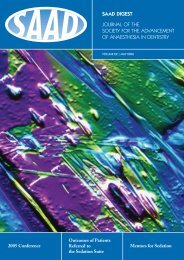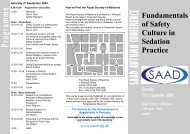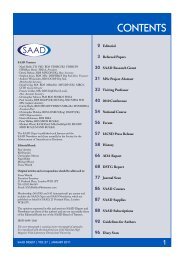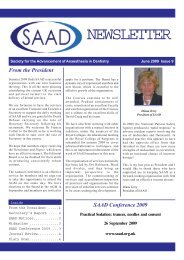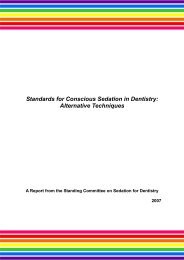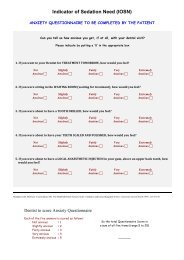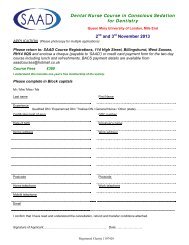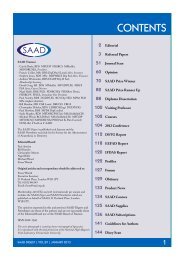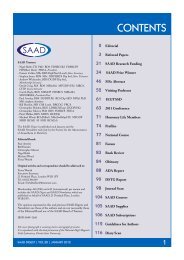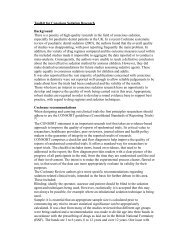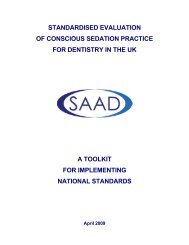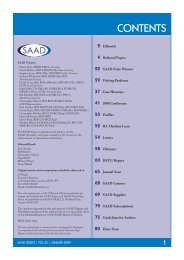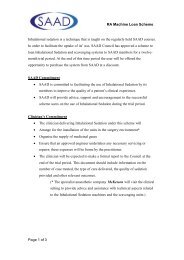Volume 24 - The Society for the Advancement of Anaesthesia in ...
Volume 24 - The Society for the Advancement of Anaesthesia in ...
Volume 24 - The Society for the Advancement of Anaesthesia in ...
You also want an ePaper? Increase the reach of your titles
YUMPU automatically turns print PDFs into web optimized ePapers that Google loves.
REFEREED PAPER<br />
were cry<strong>in</strong>g and 71% were bleed<strong>in</strong>g. More concern<strong>in</strong>g<br />
was that, dur<strong>in</strong>g <strong>the</strong> journey home, <strong>24</strong>% were <strong>in</strong> pa<strong>in</strong>,<br />
37% were bleed<strong>in</strong>g, 55% were drowsy and 5% vomited.<br />
At home, 15% cont<strong>in</strong>ued to bleed, 37% were cry<strong>in</strong>g and<br />
12% vomited. Dur<strong>in</strong>g <strong>the</strong> post-operative <strong>in</strong>terviews, vivid<br />
accounts <strong>of</strong> <strong>the</strong> experience were recounted. One patient<br />
remembered struggl<strong>in</strong>g to remove <strong>the</strong> anaes<strong>the</strong>tic mask<br />
dur<strong>in</strong>g gaseous <strong>in</strong>duction. Several remembered cry<strong>in</strong>g<br />
and feel<strong>in</strong>g sick after <strong>the</strong> procedure, with some describ<strong>in</strong>g<br />
nightmares and feel<strong>in</strong>gs <strong>of</strong> reluctance to return to <strong>the</strong><br />
dental surgery <strong>in</strong> future.<br />
Enever et al. (12) compared post-operative morbidity<br />
follow<strong>in</strong>g day-case DGA <strong>in</strong> patients with and without<br />
disabilities. Patients received a range <strong>of</strong> restorative and<br />
surgical procedures. Treatment was significantly more<br />
prolonged than <strong>in</strong> <strong>the</strong> two studies mentioned above; 76%<br />
<strong>of</strong> procedures lasted over 30 m<strong>in</strong>utes and 20% lasted over<br />
an hour. No significant difference <strong>in</strong> morbidity was found<br />
<strong>in</strong> patients with or without disabilities. 44% reported<br />
post-operative symptoms. Nausea or vomit<strong>in</strong>g occurred <strong>in</strong><br />
20% <strong>of</strong> patients and 13% required analgesia at home.<br />
All three <strong>of</strong> <strong>the</strong> above studies appear to portray treatment<br />
under DGA to be associated with a significant degree <strong>of</strong><br />
morbidity. However, <strong>the</strong> major flaw with all three studies<br />
is <strong>the</strong> lack <strong>of</strong> a control group.<br />
Methodology<br />
Methodology is <strong>the</strong> process by which researchers bridge<br />
<strong>the</strong> gap between philosophical <strong>the</strong>ory and appropriate<br />
practical research methods (13) . When decid<strong>in</strong>g on an<br />
appropriate method <strong>of</strong> data collection, it is essential to<br />
focus on <strong>the</strong> research question and aims <strong>of</strong> <strong>the</strong> research.<br />
<strong>The</strong> research question <strong>in</strong> <strong>the</strong> present study can be<br />
expressed as:<br />
‘What were <strong>the</strong> lived experiences <strong>of</strong> children, and parents <strong>of</strong><br />
children, who underwent referral and subsequent treatment<br />
under CS at QAMC?’<br />
<strong>The</strong> aims <strong>of</strong> <strong>the</strong> study also highlight a desire <strong>for</strong> an<br />
overview <strong>of</strong> experiences, ra<strong>the</strong>r than an <strong>in</strong>-depth account<br />
<strong>of</strong> one particular aspect <strong>of</strong> <strong>the</strong> experience.<br />
Focus groups<br />
Focus groups typically consist <strong>of</strong> between six and ten<br />
purposely selected subjects, and a group facilitator.<br />
Groups normally meet on one occasion, with a session<br />
last<strong>in</strong>g between one and two hours. Discussions are<br />
recorded, and later subject to systematic analysis. <strong>The</strong><br />
key <strong>in</strong>gredient <strong>of</strong> focus groups is <strong>in</strong>teraction between<br />
group members, prompt<strong>in</strong>g <strong>the</strong>m to scrut<strong>in</strong>ise <strong>the</strong>ir<br />
own way <strong>of</strong> th<strong>in</strong>k<strong>in</strong>g by listen<strong>in</strong>g to o<strong>the</strong>rs. This <strong>in</strong> turn<br />
is <strong>in</strong>tended to trigger fur<strong>the</strong>r discussion and produce<br />
fur<strong>the</strong>r <strong>in</strong><strong>for</strong>mation. <strong>The</strong> <strong>in</strong>tended result is a broad<br />
overview <strong>of</strong> views and experiences. Discussion is guided<br />
by a facilitator but members <strong>of</strong> <strong>the</strong> group are free to<br />
ask questions <strong>of</strong> each o<strong>the</strong>r and discuss issues between<br />
<strong>the</strong>mselves. <strong>The</strong> facilitator’s ma<strong>in</strong> role is to ma<strong>in</strong>ta<strong>in</strong><br />
an acceptable degree <strong>of</strong> structure and order, while<br />
encourag<strong>in</strong>g discussions to take place.<br />
<strong>The</strong>re are some potential pitfalls <strong>in</strong> <strong>the</strong> use <strong>of</strong> focus groups.<br />
<strong>The</strong>re is limited potential <strong>for</strong> collect<strong>in</strong>g data on an<br />
<strong>in</strong>dividual basis. <strong>The</strong>re is also <strong>the</strong> potential <strong>for</strong> alienation<br />
<strong>of</strong> group members and reluctance to express personal<br />
feel<strong>in</strong>gs <strong>in</strong> front <strong>of</strong> o<strong>the</strong>rs. <strong>The</strong> facilitator must have <strong>the</strong><br />
skills to stimulate and guide discussion, and to <strong>in</strong>clude all<br />
members <strong>of</strong> <strong>the</strong> group <strong>in</strong> <strong>the</strong> discussion, while ma<strong>in</strong>ta<strong>in</strong><strong>in</strong>g<br />
<strong>the</strong> structure <strong>of</strong> <strong>the</strong> session. Focus groups were <strong>the</strong> most<br />
likely research tool to meet <strong>the</strong> aims <strong>of</strong> <strong>the</strong> study.<br />
Study design<br />
Subjects<br />
Ethical approval was sought and granted. A purposive<br />
sample <strong>of</strong> children between 6 and 14 years old were<br />
allocated <strong>in</strong>to focus groups. Allocation was determ<strong>in</strong>ed<br />
by two variables. <strong>The</strong> first variable was <strong>the</strong> age <strong>of</strong> <strong>the</strong><br />
child (groups were 6–9 years, 10–12 years and 13–14<br />
years). <strong>The</strong> second variable was <strong>the</strong> type <strong>of</strong> CS received.<br />
Recruited children had all taken part <strong>in</strong> a recent RCT<br />
described <strong>in</strong> <strong>the</strong> background section (4) . Allocation was<br />
based on <strong>the</strong> CS <strong>in</strong>tervention <strong>the</strong>y had been allocated to<br />
and whe<strong>the</strong>r <strong>the</strong> technique had facilitated <strong>the</strong> successful<br />
completion <strong>of</strong> <strong>the</strong>ir planned treatment or not. This gave<br />
two focus groups <strong>for</strong> each age group, mak<strong>in</strong>g six child<br />
focus groups <strong>in</strong> total. Each focus group was <strong>in</strong>tended<br />
to conta<strong>in</strong> between six and eight subjects who had had<br />
a variety <strong>of</strong> techniques and a variety <strong>of</strong> outcomes. Six<br />
additional and separate groups were composed <strong>of</strong> <strong>the</strong><br />
parents <strong>of</strong> <strong>the</strong> selected children, giv<strong>in</strong>g a total <strong>of</strong> 12 groups.<br />
Data Collection<br />
Focus group discussions took place at a local hotel. A<br />
standardised topic guide was used as a framework around<br />
which discussions were based.<br />
Data was collected by digital audio record<strong>in</strong>g. <strong>The</strong><br />
record<strong>in</strong>gs were later transcribed verbatim <strong>in</strong>to a<br />
Micros<strong>of</strong>t Word document. Data from <strong>the</strong> transcripts was<br />
transferred to a Micros<strong>of</strong>t Excel spreadsheet. Along <strong>the</strong><br />
vertical axis were coded details <strong>of</strong> <strong>the</strong> participants. Along<br />
<strong>the</strong> horizontal axis were subhead<strong>in</strong>gs correspond<strong>in</strong>g to<br />
SAAD DIGEST | VOL.<strong>24</strong> | JANUARY 2008 5




